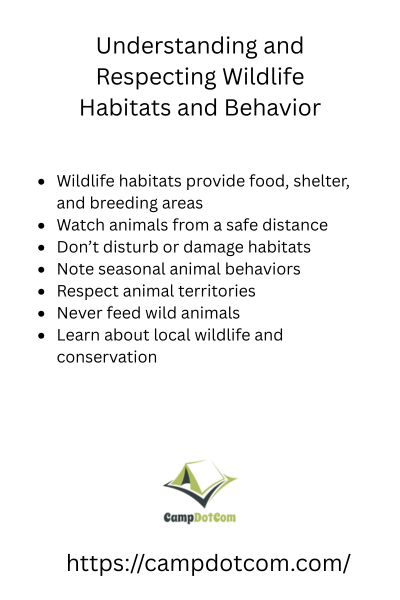Understanding and respecting wildlife habitats and behavior is more than just a rule to keep you away from bears (although yes definitely do that). It is actually one of the most important things you can do as someone who loves the outdoors. Whether you are hiking, camping, or just relaxing by a lake, the way you interact with nature leaves a lasting impact both for you and for the environment.
Read More About Understanding and Respecting Wildlife Habitats and Behavior

It’s Their Home, Not Our Playground
I remember this one camping trip up in the Smokies. We were halfway through breakfast when a curious raccoon waltzed into our site like he owned the place. Honestly, he kinda did. Turns out, someone at a neighboring site left their trash unsecured the night before. Rookie mistake and one that teaches you real quick about the consequences of not understanding and respecting wildlife habitats and behavior.
Wild animals are not just background scenery for our Instagram photos. They have routines, territories, and instincts and we mess all that up when we ignore the signs or stomp right through their living rooms.
As an Amazon Associate, I earn from qualifying purchases. Some of the links in this article are affiliate links. This means that, at zero cost to you, I will earn an affiliate commission if you click through the link and finalize a purchase.
More Things to Know About Understanding and Respecting Wildlife Habitats and Behavior

Respect Starts with Observation
Have you ever just paused and watched an animal doing its thing in the wild? It’s like watching a perfectly tuned machine. Squirrels dart from tree to tree without a second thought. Birds call out to each other like they’re running some secret forest network. It’s incredible.
But the moment we interrupt that by getting too close or making loud noises we break the natural flow. Understanding and respecting wildlife habitats and behavior starts with observing from a distance. Binoculars become your best friend and so does a zoom lens. Getting that perfect shot should never come at the cost of the animal’s peace and comfort.
Feeding Wildlife? Please Don’t.
I get it sharing a little crumb of your granola bar with that cute chipmunk feels harmless but here’s the thing it really is not. Wild animals that get used to human food can become aggressive, dependent, or even get sick. Plus it messes with their natural diet and the way they find food.
This is all part of understanding and respecting wildlife habitats and behavior. Let them find food the way nature intended. The less they rely on us the healthier they stay and the safer we all are.
Stick to the Trails, Even When You’re Feeling Adventurous
Blazing your own trail sounds romantic, doesn’t it? Like you’re some kind of rugged explorer. But going off-path can destroy delicate habitats. Wildflowers, nests, dens—they’re all easily crushed under our boots.
You might not see the damage right away, but it adds up. Following marked trails isn’t just about not getting lost. It’s about keeping wildlife homes intact. That’s what understanding and respecting wildlife habitats and behavior really means: making choices that protect the creatures we love to admire.
Nighttime Rules Are a Whole Different Game
Night hikes are awesome but they come with extra responsibilities. Many animals are active at night which means it is their prime time to hunt eat and care for their babies. Bright flashlights loud conversations or noisy campfire parties can really disturb them.
I once saw an owl swoop down during a quiet walk at dusk. Silent and majestic it honestly gave me goosebumps. That kind of magic only happens when we move respectfully through the space. Understanding and respecting wildlife habitats and behavior at night means keeping things low key and letting nature do its thing.
What to Do If You Run Into an Animal
Let’s be real running into wildlife can be both thrilling and scary. But panicking or trying to get close to a wild animal is not the way to go.
Instead stop and watch. Stay calm and slowly back away if you need to. Most animals are not looking for trouble they just want their space. The more we learn about how animals behave the better we get at handling these moments. That is what understanding and respecting wildlife habitats and behavior is all about knowing how to react without causing harm.
Think Like a Guest When Exploring Wildlife Habitats
Understanding and respecting wildlife habitats and behavior is not about being perfect. It’s about being aware. Aware that every trail we hike, every noise we make, and every snack we leave behind affects the lives of the creatures who call those places home.
And honestly the more we understand them, the richer our outdoor experiences become. I’ve had some of my most unforgettable moments in the wild just by sitting still and watching. No selfies, no snacks just wonder.
So next time you’re out there, think like a guest. Be quiet, be curious, and above all be respectful. Nature is already doing its thing beautifully. Let’s not mess that up.
